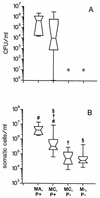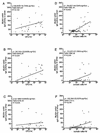Longitudinal analysis of Prototheca zopfii-specific immune responses: correlation with disease progression and carriage in dairy cows
- PMID: 12624049
- PMCID: PMC150299
- DOI: 10.1128/JCM.41.3.1181-1186.2003
Longitudinal analysis of Prototheca zopfii-specific immune responses: correlation with disease progression and carriage in dairy cows
Abstract
In order to characterize the humoral and cellular immune responses to bovine mammary protothecosis, serum and whey samples obtained from 72 dairy cows assigned to four different clinical stages of infection were examined for specific antibodies by indirect enzyme-linked immunosorbent assay techniques. Milk samples were analyzed for the total numbers of excreted algal cells and somatic cells. After characterization of the course of immune induction in bovine protothecal mastitis, a long-term sentinel study was performed in an affected herd in order to investigate disease progression. A total of 61 dairy cows with protothecal mastitis were examined for shedding of algae cells and for local immune responses three times in 6-month intervals. During acute and chronic stages of protothecosis, significantly elevated specific antibody activities in sera were detected. A strong correlation of whey immunoglobulin A (IgA) and whey IgG1 antibody activity with the total counts of somatic cells in milk was observed, whereas only a weak correlation of whey IgA and whey IgG1 concentrations to the number of algal cells excreted with the milk was seen. Our results from the sentinel long-term study of infected cows revealed that 70.5% of the persistently infected animals were continuously shedding the pathogen. About 4.9% of the animals showed an intermittent shedding, whereas 18% of the cows were tested culturally negative throughout the study. It can be assumed that Prototheca zopfii mastitis in dairy cows is maintained on the herd level by subclinically infected alga-shedding cows.
Figures


References
-
- Aalbaek, B., H. E. Jensen, and A. Huda. 1998. Identification of Prototheca from bovine mastitis in Denmark. APMIS 106:483-488. - PubMed
-
- Anderson, K. L., and R. L. Walker. 1988. Sources of Prototheca spp. in a dairy herd environment. J. Am. Vet. Med. Assoc. 193:553-556. - PubMed
-
- Baumgärtner, B. 1997. Vorkommen und Bekämpfung der Protothekenmastitis des Rindes im Einzugsgebiet des Staatlichen Veterinär- und Lebensmitteluntersuchungsamtes Potsdam. Prakt. Tierarzt. 78:406-414.
-
- Bianchi, M., A. M. Robles, R. Vitale, S. Helou, A. Arechavala, and R. Negroni. 2000. The usefulness of blood culture in diagnosing HIV-related systemic mycoses: evaluation of a manual lysis centrifugation method. Med. Mycol. 38:77-80. - PubMed
-
- Blaschke-Hellmessen, R., H. Schuster, and V. Bergmann. 1985. Differenzierung von Varianten bei Prototheca zopfii (Krüger 1894). Arch. Exp. Veterinarmed. 39:387-397. - PubMed
MeSH terms
LinkOut - more resources
Full Text Sources
Miscellaneous

